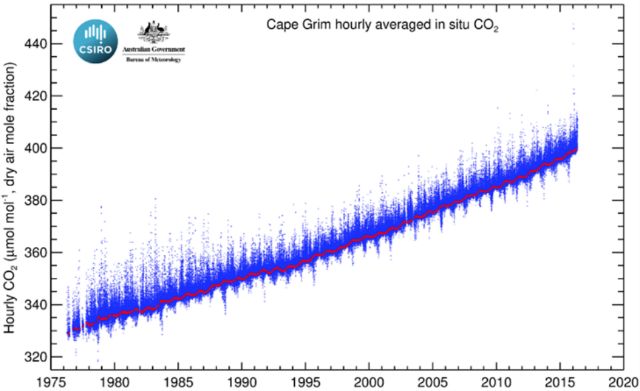Dangerous New Normal As 400 ppm Carbon Baseline Expected Within Days
By Lauren McCauley
11 May, 2016
CommonDreams.org
The planet is hurtling towards a disturbing milestone as researchers predict that the southern hemisphere "within days" will reach a new atmospheric baseline of 400 parts per million (ppm) of carbon, signifying that humanity has entered a new phase in our climate impact.
"Once it's over [400 ppm], it won't go back," Paul Fraser, a retired fellow with Australia's Commonwealth Scientific and Industrial Research Organization (CSIRO), told the Sydney Morning Herald on Tuesday. "It could be within 10 days."
The symbolic climate threshold is expected to be recorded at the Cape Grim monitoring site, on the northwestern point of Tasmania, which is jointly run by CSIRO and the Bureau of Meteorology and said to capture "the most accurate reading of the atmospheric conditions in the southern hemisphere." On May 6, a CSIRO team took a reading of 399.9 ppm.
The 400 ppm milestone has been reached before. First, in May 2013 at the National Oceanic and Atmospheric Administration's (NOAA) observatory in Mauna Loa, Hawaii and later in Alaska. But, in both those cases, the carbon concentration later dipped back down with the seasonal cycle. Unfortunately, as Fraser warned, this new record may be here to stay. The Herald explains:
With less land in the south, there is also a much smaller fluctuation according to the seasonal cycle than in northern hemisphere sites. That's because the north has more trees and other vegetation, which take up carbon from the atmosphere in the spring and give it back in the autumn. So while 400 ppm has been temporarily exceeded at the other two main global stations since 2013 - in Hawaii and Alaska - they have dropped back below that level once spring has arrived because of that greater seasonal variation.
Fraser estimates that CO2 levels are rising fast—roughly 3 ppm each year. Once the 400 ppm level is reached it "will take a few weeks to verify."
The chart below shows 40 years of records taken at Cape Grim with the red line denoting the baseline concentration of CO2.

Australian Greens deputy leader Larissa Waters said the landmark "should act as a global wake-up call and must shock both Australian big political parties out of their blind coal-obsession which is literally cooking our planet and our Great Barrier Reef."
As The Herald notes, the likely 400 ppm record will be reached as Australian Prime Minister Malcolm Turnbull continues to push new coal infrastructure projects and oppose proposals to lower emissions in compliance with the COP21 climate agreement. What's more, it follows an announcement that the government is slashing 275 jobs at CSIRO, mostly in climate science.
This work is licensed under a Creative Commons Attribution-Share Alike 3.0 License

